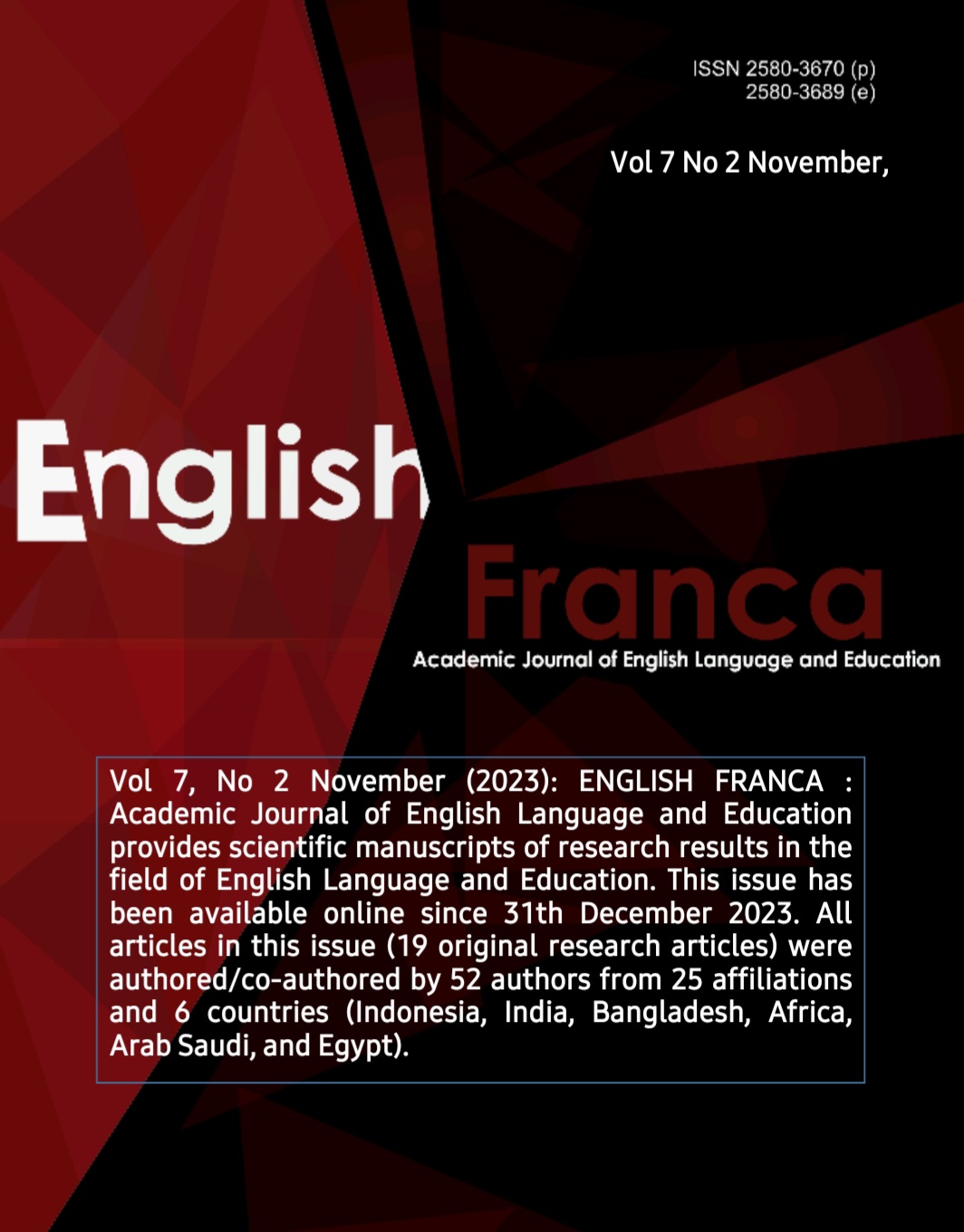The Use of the Story Telling Method to Improve Student Speaking Ability
DOI:
https://doi.org/10.29240/ef.v7i2.8486Keywords:
Story Telling, Speaking Ability, Senior High School.Abstract
This study aims to find evidence of the method learning storytelling can improve students speaking ability at SMA Negeri 5 Metro. The total sample involved was 59 students. The method used in this studys a quasi-experimental. The result of Data analysis showed that the post-test mean score was higher than the pre-test (54.06 > 44.27). This shows the results of the analysis which show that the t value obtained is higher than the t table (17,067 > 2,048). then the second data shows that the t-test value obtained is greater than the t-table (3,269 > 2.021), it can be concluded that learning to speak using storytelling in the even semester of class XI SMA Negeri 5 Metro can improve abilities. Therefore, the alternative hypothesis (Ha) is accepted and the null hypothesis (Ho) is rejected. This means that the use of story telling provides an improvement in students' speaking.
Downloads
References
A. Gani, S., Fajrina, D., & Hanifa, R. (2015). Students’ Learning Strategies for Developing Speaking Ability. Studies in English Language and Education, 2(1), 16. https://doi.org/10.24815/siele.v2i1.2232
Arikunto, S. (2002). Prosedur Penelitian Suatu Pendekatan Praktek.
Brown, H. D. (2003). Language assessment principles and Classroom Practices. 1–400.
Creswell, J. W. (2012). Educational research: planning, conducting, evaluating, quantitative and qualitative research (Fourth Edition). United State of America: Pearson Education Inc.
Dewi, H. (2016). PROJECT BASED LEARNING TECHNIQUES TO IMPROVE SPEAKING SKILLS. PENGARUH PENGGUNAAN PASTA LABU KUNING (Cucurbita Moschata) UNTUK SUBSTITUSI TEPUNG TERIGU DENGAN PENAMBAHAN TEPUNG ANGKAK DALAM PEMBUATAN MIE KERING, 1(2), 274–282.
Efrizal, D. (2012). Improving Students’ Speaking through Communicative Language Teaching Method at Mts Ja-alhaq, Sentot Ali Basa Islamic Boarding School of Bengkulu, Indonesia. International Journal of Humanities and Social Science, 2(20), 127–134.
Fauzia, F. S. (2019). PERFORMANCE IN PUBLIC SPEAKING CLASS AT ENGLISH LANGUAGE EDUCATION DEPARTMENT, ISLAMIC UNIVERSITY OF INDONESIA. 1–19.
Harmer, J. (2007). How To Teach English-Jer.
Khorashadyzadeh, A. (2014). Why to use short stories in speaking classes? International Journal of Foreign Language Teaching in the Islamic World, 2(1), 9-15. 27–69.
Purwatingsih. (2015). Improving Speaking Ability Through Story Telling. Journal on English as a Foreign Language, 5(1), 57–66. http://e-journal.iain-palangkaraya.ac.id/index.php/jefl/article/view/93
Richards, J. C. (2008). Teaching Listening and Speaking. In Language Teaching (Vol. 35, Issue 4). https://doi.org/10.1017/S0261444802211829
Sayuri. (2016). English Speaking Problems of EFL Learners of Mulawarman University. English Speaking Problems of EFL Learners Indonesian Journal of EFL and Linguistics, 1(1), 2016. https://doi.org/10.21462/ijefll.v1i1.4
Sugiyono. (2007). Dokupdf_com_ebook_statistik_untuk_peneli. In Statika Untuk Penelitian (Vol. 12, pp. 1–415).
Tahir, S. Z. A. (2015). Improving Students Speaking Skill through Yahoo Messenger at University of Iqra Buru. International Journal of Language and Linguistics, 3(3) 174-181. doi: 10.11648/jill 20150303 20. Paper Knowledge . Toward a Media History of Documents, 43–65. https://doi.org/10.11648/jill 20150303 20
Wilson, D. G. (2015). Storytelling in Organizations : The power and traps of using stories to share knowledge in organizations. Training and Development, 53(January 2002), 1–12.
Downloads
Published
How to Cite
Citation Check
License
Authors who publish with this journal agree to the following terms:
- Authors retain copyright and grant the journal right of first publication with the work simultaneously licensed under a Creative Commons Attribution License (CC BY-NC-SA 4.0) that allows others to share the work with an acknowledgment of the work's authorship and initial publication in this journal.
- Authors are able to enter into separate, additional contractual arrangements for the non-exclusive distribution of the journal's published version of the work (e.g., post it to an institutional repository or publish it in a book), with an acknowledgment of its initial publication in this journal.
- Authors are permitted and encouraged to post their work online (e.g., in institutional repositories or on their website) prior to and during the submission process, as it can lead to productive exchanges, as well as earlier and greater citation of published work (See The Effect of Open Access).









